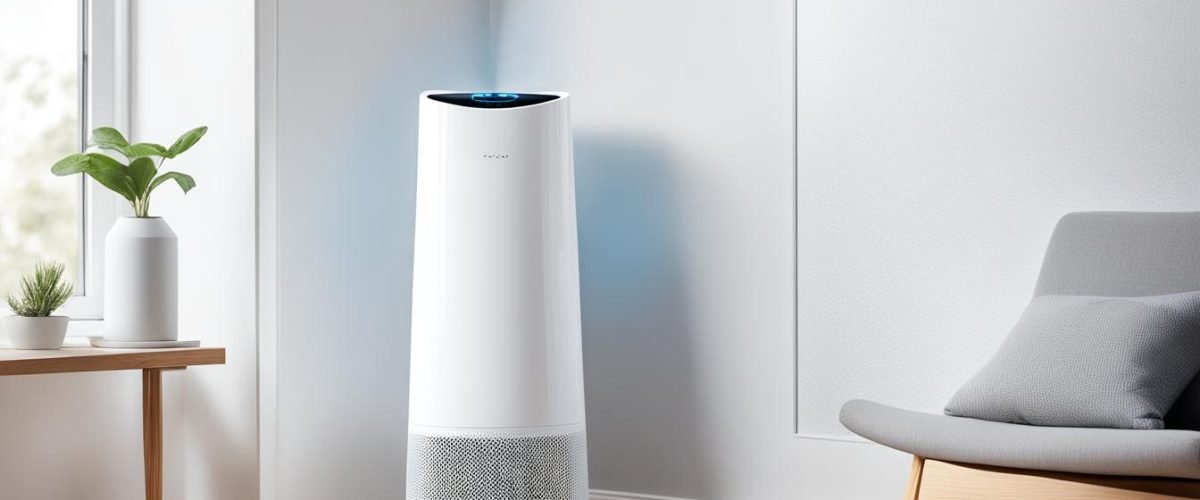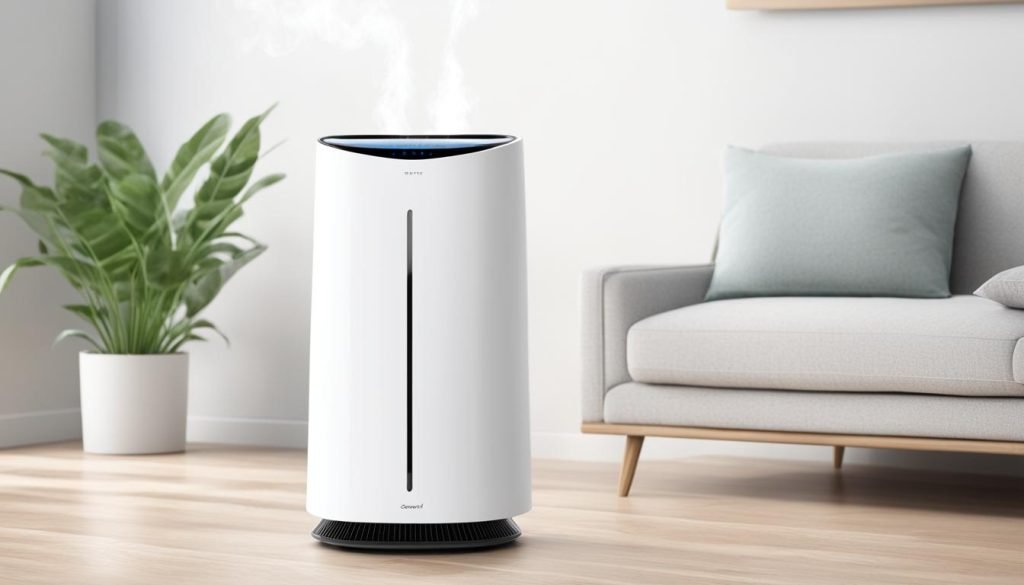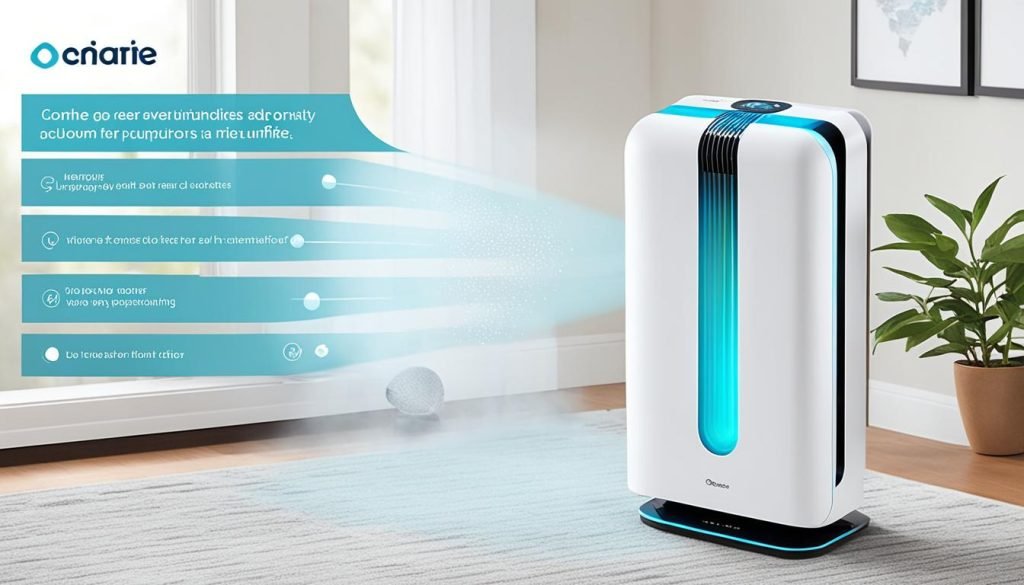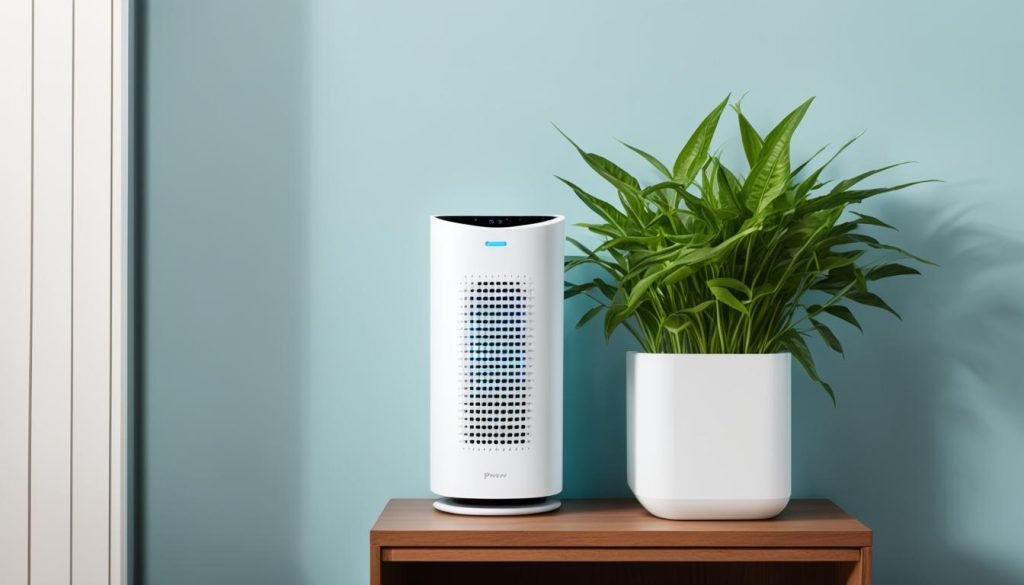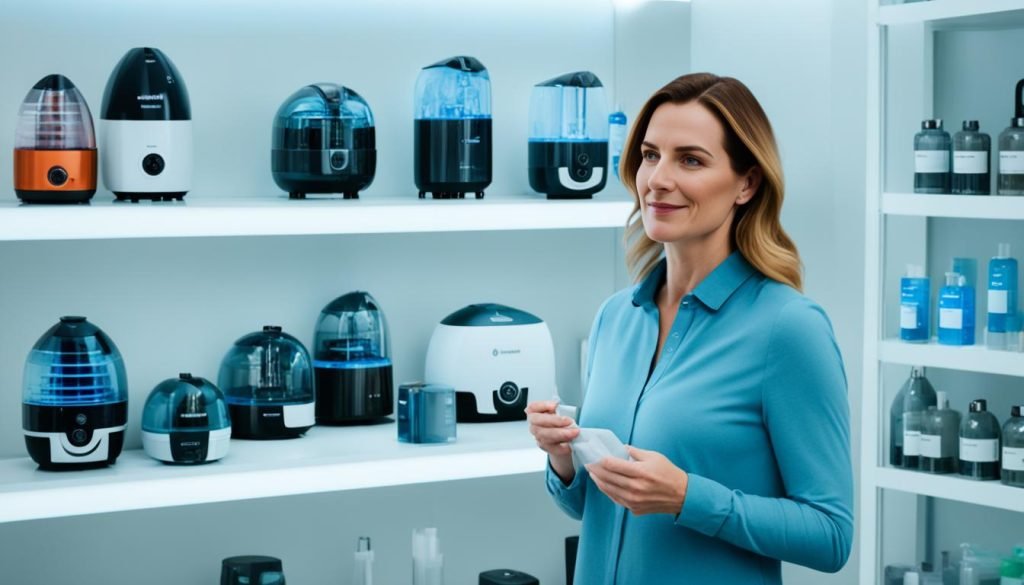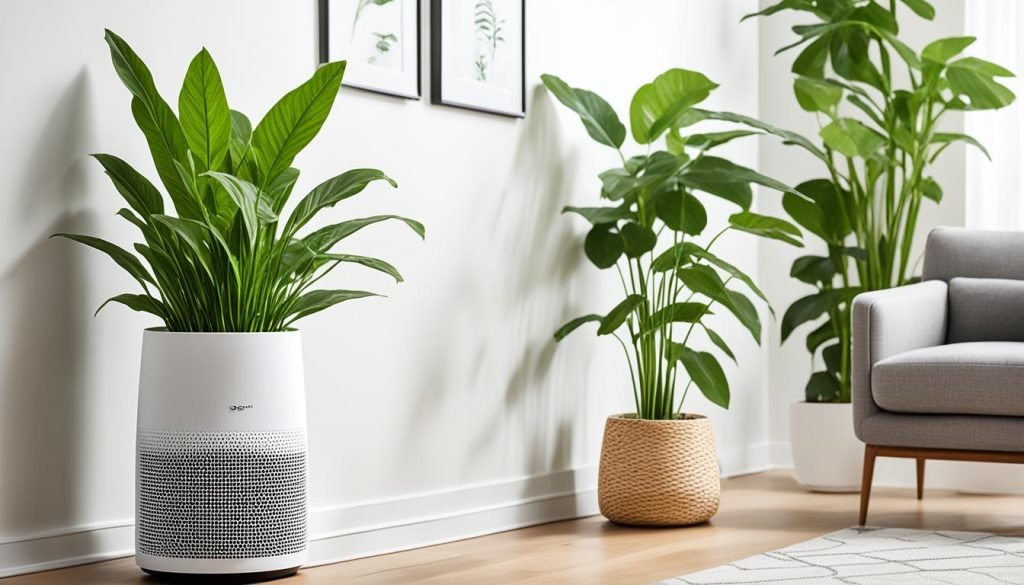Merging an air purifier with a humidifier solves many indoor air problems. This combo handles allergens, dust, and dryness, boosting comfort and health at home. I care about the air I take in. That’s why I know these machines are key for a healthier home.
Air purifiers are great for taking out the bad stuff from the air, like dust and pets’ fur. They’re a big help for anyone with breathing issues. Humidifiers, on the other hand, make air less dry. This helps with problems like scratchy throats and itchy skin.
Using an Air Oasis Cool Mist Humidifier and Essential Oil Diffuser brings many pluses. You get better sleep, less chance of getting sick, and easier breathing. Though humidifiers don’t clean the air, they do make it feel better and help with dry noses.
Keeping these devices in good shape is crucial for top air quality. Clean air gadgets work best and don’t create new problems. So, we can relax and live healthier in our cozy homes.
Introduction to Air Purifiers and Humidifiers
Creating a healthy home begins with knowing what air purifiers and humidifiers do. They help with home air quality. This makes the air you breathe better by working together.
Understanding the Basics
An air purifier cleans the air by removing things like dust and pollen. It uses special filters to catch the tiny bits. This cuts down on allergens and germs. A humidifier, on the other hand, makes the air moister. It can help with dry skin and stuffy noses. Humidifiers come in different types. Some make a cool mist with vibrations. Others use a fan and wet material to add moisture.
Keeping your home’s humidity at 40% to 60% is key for health. This stops germs from spreading. But too much moisture can cause mold. By using both air purifiers and humidifiers, you can handle several air problems at once.
Why Indoor Air Quality Matters
The air we breathe at home affects our health. Air purifiers can help a lot, especially if you have asthma. They take out things that trigger asthma attacks. Did you know one in every 12 adults has asthma? These machines can ease their symptoms by cutting down on allergens.
Also, the right humidity level makes your house feel nice. Certain humidifiers can be part of your air system. Others use a spinning disk to spread mist. They keep the air just moist enough. This makes your home’s air better and reduces damage to stuff like furniture.
Both air purifiers and humidifiers need care to work well. You should change the filter in your air purifier every 3-6 months. Humidifiers need more regular cleaning to stop mold. These items come in different sizes and types, which can affect their cost. Remember, getting a top-rated air purifier and humidifier is a good investment for your family’s health.
How Air Purifiers Work
Air purifiers are devices that clean air indoors. They remove dust and other harmful things. This makes the air safe for us to breathe inside. Let’s learn more about these helpful machines.
Types of Air Purifiers
There are many air purifiers out there. They all work in different ways to make the air cleaner. Let’s see how each type helps.
- HEPA Filters: These are very efficient. They can catch 99.97% of tiny particles. Things like dust, pollen, and germs can’t get through.
- Activated Carbon Filters: They are great for removing bad smells and gases. This includes smoke and chemical fumes. They work well with HEPA filters.
- UV Light Air Purifiers: They use UV light to kill germs. This makes the air cleaner and safer to breathe.
- Ionizers: Ionizers send out ions to capture dust and other small particles. This helps keep the air clean.
Benefits of Using Air Purifiers
Air purifiers can make a big difference in your home. They get rid of pollutants that can be harmful. Berkeley Lab says they help with allergies, asthma, and other health problems. They make us feel better and breathe easier.
In dry seasons, an air purifier that also adds moisture is great. It makes sure the air isn’t too dry. But remember, changing the filters often is key to their performance.
Having an air purifier means taking care of your home’s air. It keeps the bad stuff out, making your place healthier and more pleasant.
How Humidifiers Enhance Indoor Air Quality
Humidifiers bring many humidifier health benefits by keeping the moisture levels just right in our houses. The ideal humidity range is 30-50%. Such a level can greatly improve indoor air quality. It cuts down on dry air effects like dry skin, stuffy nose, and sinus pain. This makes our living space more cozy.
Benefits of Optimal Humidity Levels
Keeping optimal humidity is key for health and preserving items at home. The right humidity keeps our skin and hair moist, stops static cling, and helps objects like wood furniture and instruments last longer. Using distilled water in humidifiers prevents mineral and mold buildup. This keeps the air fresh and full of moisture.
Health Advantages of Using Humidifiers
Using a humidifier brings lots of humidifier health benefits. It can stop colds and flu, ease throat pain, and make sleeping better. It also takes care of dry air downsides like eye and throat irritation. For those with allergies, it calms down the allergic reactions by making the air moister.
In some cases, when allergies are bad, running an air purifier and a humidifier at the same time can do wonders for air quality. If we regularly check and adjust these devices, our home air will become healthier and more pleasant. This means we can breathe easier in our own spaces.
The Best Air Purifiers for Various Needs
Choosing the best air purifier or combo for your home depends on what you need. If you need help with allergies or smoke, certain devices are made just for that. So, make sure to look for the one that matches what you’re looking for.
The Levoit Air Purifier stands out because it works really well and it’s easy to use. It’s perfect for medium-sized rooms, up to 403 square feet. If your space is smaller, try the smaller version of the Levoit. It can clean the air in rooms up to 178 square feet.
Got a big room to clean up? The Clorox Large Room Air Purifier is great for spaces up to 1,500 square feet. There’s also the Aroeve Air Purifiers for Large Spaces, working in areas up to 1,095 square feet. It’s a bit lighter and a bit smaller.
If you want an all-in-one device, check out the Dyson Purifier Humidify+Cool. It’s great for purifying the air and making it moister. Keep in mind, it’s on the pricier side at $999. It’s perfect for spaces up to 400 square feet.
| Model | Dimensions (inches) | Weight (lbs.) | Room Size (sq. ft.) | Price ($) |
|---|---|---|---|---|
| Levoit Air Purifier | 10.79 x 10.79 x 20.47 | 12.79 | 403 | 179.99 |
| Levoit Air Purifier for Small Spaces | 6.5 x 6.5 x 10.4 | 2.2 | 178 | 89.99 |
| Clorox Large Room Air Purifier | 10 x 10 x 19 | 12.72 | 1,500 | 329.99 |
| Aroeve Air Purifiers | 13.5 x 7.5 x 17.25 | 8.63 | 1,095 | 189.99 |
| Dyson Purifier Humidify+Cool | 36.33 x 11.02 x 12.23 | 18 | 400 | 999 |
The Levoit Core 400S Smart True HEPA air purifier covers large areas, up to 990 square feet. The Home Depot has a good one for pet hair, priced at $399. Plus, the Kenmore 850e Air Purifier is great for rooms up to 850 square feet.
To really tackle smoke or allergies, you need an air purifier with advanced filters like HEPA. The Coway Airmega AP-1512HH Mighty Air Purifier is often recommended. It has been tested over 20 times and is known for being both durable and efficient.
Choosing the Right Humidifier for Your Home
When picking out a humidifier for your house, think about your needs carefully. The choice you make can change your comfort and health. This includes issues like congestion or needing to improve moisture in your skin.
Start by looking at the size of the room. The Honeywell HCM-350 is a popular choice that works well for areas up to 500 square feet. It’s great for large rooms or bedrooms. For smaller spaces, you’ll want something more compact.
Consider what kind of mist you want. Cool mist is good all year and safe for kids. Warm mist, on the other hand, can be soothing in colder weather.
Maintenance is key, too. You’ll have to clean and refill the tank to keep it free of germs. Choosing a model that’s easy to clean can save you a lot of time and hassle.
Think about the health benefits, as well. Humidifiers can keep the air at an ideal moisture level to help with dry skin, congestion, and allergies. They are especially good for babies, easing dry skin and avoiding breathing problems.
A good humidifier, when combined with regular cleaning and proper maintenance, can maintain a healthy and comfortable indoor environment.
Would you like a humidifier that works with smart home systems? Some can connect to Google Home or Amazon Alexa. This is great for those who love new technology because it offers more convenience.
| Model | Coverage Area | Maintenance Needs | Price Range |
|---|---|---|---|
| Honeywell HCM-350 | 500 sq ft | Regular cleaning required | $ |
| Levoit LV600HH | 753 sq ft | Moderate maintenance | $$ |
| Dyson AM10 | 200 sq ft | Minimal maintenance | $$$ |
There are many models, each with its own strengths. The Honeywell HCM-350 is reliable and simple. The Levoit LV600HH covers more space, great for bigger rooms. The Dyson AM10 is for those who love advanced features.
The best humidifier depends on your health needs and lifestyle. Figure out if you need it for congestion or to fit with your smart home. The right choice will improve your indoor air and well-being.
Can You Use an Air Purifier and Humidifier Together?
Using an air purifier and a humidifier together is a smart mix for better indoor air. They each do their own job but work well together. When you have an air purifier and humidifier for home, you tackle dust and keep the air just right.
In winter, the air gets dry because of heating. Humidifiers add moisture back, stopping dry skin and stuffy noses. When you also run an air purifier, you keep the air clean and at the right humidity level. It’s the perfect way to deal with both problems.
A dual function air purifier with special filters can catch tiny particles, like viruses. This helps make the air safer from sickness, including COVID-19. Humidifiers also have a role in lowering virus spread.
The EPA suggests keeping indoor humidity at 30% to 60%. This range is great for the air purifier and prevents mold. Regular cleaning and filter changes make sure your devices are working well together.
Place your air purifier and humidifier a bit apart to stop problems. This stops the air purifier’s filters from getting wet. Special devices that do both can save energy and money.
During allergy seasons and winter, using both devices is super helpful. They fight allergens and keep the air just right. This means a healthier and more comfortable home.
In the end, using an air purifier and humidifier for home is a strong step for better air. With the right spot and upkeep, they make a big difference in your home’s feel and health.
Top Air Purifier and Humidifier Combo Units
If you’re looking for a way to improve the air you breathe, consider air purifier and humidifier combos. These devices offer the best of both worlds, cleaning the air and adding moisture. This saves space while adding more to your home’s air quality.
The Dyson Purifier Humidify+Cool Formaldehyde is a top choice. It can clear 95% of PM2.5 and PM10 particles in just 30 minutes and eliminate 75% of formaldehyde. With a sizeable humidifier tank, it keeps the air moist for up to 36 hours. This makes it great for long term use.
Looking for something more affordable? The Afloia 2 in 1 HEPA Air Purifier with Humidifier is effective and low-cost. It can clean a room up to 438 sq ft. It’s on sale at Amazon. For bigger spaces, check out the Brondell Revive True HEPA Air Purifier & Humidifier. It’s good for areas up to 627.5 sq ft. It also helps with allergies and pumps out water at a rate of 350 mL per hour.
The Sharp Smart Plasmacluster Ion Air Purifier with True HEPA + Humidifier is perfect for very large rooms, going up to 2,603 sq ft. But there’s also the ORB 2 in 1 Air Purifier and Humidifier for smaller spaces, working well in areas up to 300 sq ft.
| Model | Coverage Area (sq ft) | Key Features | Price |
|---|---|---|---|
| Dyson Purifier Humidify+Cool Formaldehyde | N/A | 95% PM2.5/PM10 removal, 75% formaldehyde removal, 36 hours of moisture | $1,000 (Dyson), $850 (Macy’s) |
| Afloia 2 in 1 HEPA Air Purifier with Humidifier | 438 | Budget-friendly, effective in small rooms | $140 (Amazon) |
| Brondell Revive True HEPA Air Purifier & Humidifier | 627.5 (regular), 376.5 (allergy sufferers) | High water output rate, dual-coverage | $400 (Brondell, 20% off) |
| Sharp Smart Plasmacluster Ion Air Purifier with True HEPA + Humidifier | 2,603 | Ideal for large spaces, True HEPA filtration | $350 (Amazon) |
| ORB 2 in 1 Air Purifier and Humidifier | 300 | Effective small area coverage | N/A |
There’s a wide range of choices, from budget-friendly to high-end. You can find exactly what you need, whether it’s for a big room or to handle specific health concerns. These units offer a complete solution for your air quality needs.
Affordable Solutions for Better Air Quality
Finding affordable air purifiers and humidifiers is key for better air quality. Many brands make devices that clean the air without costing a fortune. Here are some excellent choices that won’t burn a hole in your pocket but still work well.
| Model | Price | Coverage Area | Features |
|---|---|---|---|
| Top Overall Combo: Dyson Purifier Humidify+Cool Formaldehyde | $1,000 at Walmart, $999 at Amazon, $800 at Dyson | 800 sq ft | Removes more than 95% of PM2.5 and PM10 particles, 1-gallon reservoir |
| Best Value Combo: Afloia 2 in 1 HEPA Air Purifier with Humidifier | $119 at Amazon | 438 sq ft | Multi-stage HEPA filter, modular design |
| Best for Allergies: Brondell Revive True HEPA Air Purifier & Humidifier | $500 at Amazon, $400 at Wayfair, $500 at Walmart | 627.5 sq ft | Auto-humidify setting, two True HEPA filters |
| Best for Large Spaces: Sharp Smart Plasmacluster Ion Air Purifier with True HEPA + Humidifier | $613 at Amazon, $630 at Wayfair | 2,603 sq ft | Alexa and Google Assistant compatible, weekly scheduler |
| Best for Bedrooms: ORB 2 in 1 Air Purifier and Humidifier | $118 at Amazon | 300 sq ft | Compact design, True HEPA and activated carbon filter |
Mixing and matching these options is a smart way to get cleaner air on a budget. For your home, you can find the right system. From Dyson’s powerful purifying to Afloia’s small-space solution, you can get what you need without spending too much.
Maintaining Your Air Purifier and Humidifier
Keeping your air purifier and humidifier clean is key. It makes them work well and last long. The EPA says keep humidity between 30% and 60%. This helps both devices work effectively.
Place your air purifier and humidifier a good distance apart. This stops the purifier’s filter from getting wet. This way, they both work better. Also, make sure to change filters and clean all parts regularly.
It’s important to rinse both daily and clean them weekly. Use vinegar or bleach to clean deeply. This stops mold and mineral buildup. It keeps your devices running longer and better.
Here are some important tips for maintenance:
- Replace filters often as advised by the maker.
- Rinse out the humidifier every day to avoid minerals.
- Do a deep clean weekly to stop mold.
- Keep an eye on the humidity for the best air quality.
Knowing how and why to keep your devices clean is crucial. It makes your air healthier. Plus, it helps your air purifier and humidifier last longer.
Common Mistakes to Avoid
Keeping the air clean at home means steering clear of easy-to-make air quality blunders. Fixing mistakes with how we use humidifiers and air purifiers boosts their health benefits indoors.
Incorrect Use of Humidifiers
It’s common to let humidity levels get too high. The EPA says we should keep indoor humidity under 60% in summer and preferably between 25% and 40% in winter. This helps stop mold, mildew, and dust mites from breeding. Remember, not using distilled or demineralized water can cause mineral buildup and more bacteria. This worsens allergies and indoor air quality.
It’s vital to clean your humidifier often, like every few days. Leaving water to stagnate in the humidifier can turn into a breeding ground for bacteria. If you use water that’s not clean or if you fail to clean your humidifier parts regularly, it can blow out a dirty mist. This dirty mist can make allergies worse by adding more mold and mildew into the air.
Ineffective Air Purifier Placements
Where you put your air purifier matters a lot. A big mistake is tucking it away in a corner or behind furniture. This can stop the purifier from working well. For best results, place air purifiers where they can get good airflow and aren’t blocked by anything. Air purifiers with activated carbon can even help soak up harmful chemicals like ammonia and formaldehyde.
Using smart apps can also be a smart move. They alert you when the air quality changes. Since most people are indoors most of the time, indoor air can get quite dirty. This fact makes the right placement and upkeep of air purifiers very important for keeping healthy.
Conclusion
Creating a healthier home with air purifiers and humidifiers can be game-changing. These devices work together to keep your indoor air clean and at the right moisture level. For example, air purifiers remove up to 99.7% of dust, pollen, and other air-born nasties.
But getting the most out of them means keeping them in good shape. Air purifiers need new filters every 3-6 months. Humidifiers, on the other hand, must prevent mold by having their water changed often. Combination units, however, offer the best of both worlds in a single gadget.
When deciding on these appliances, think about what you need and can afford. If you want something quiet or powerful, there are choices for everyone. Knowing how to take care of them means a better home environment and improved health for you and your family.



